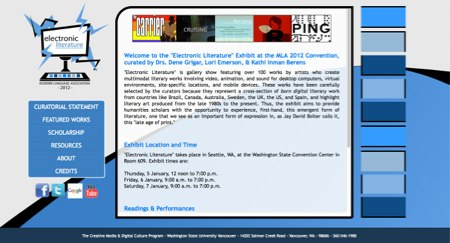Genre
Stacey Mason

MLA 2012 will host an Electronic Literature Exhibit, curated by Dene Grigar, Lori Emerson, and Kathi Inman Berens. From the exhibit website:
Because the ultimate goal is to present electronic literature in a way that makes it understandable to non-practitioners and scholars new to it, we have chosen to organize the work, first, by medium—desktop, mobile, and readings and performances—and, second, by approach and style, like locative, multimodal, and literary games, instead of genres, such as hypertext fiction or flash poetry, etc., usually associated with electronic literature.
This statement makes an interesting supposition about genre in eLit, namely that it is a relatively unchanging—a bold assumption in such a young field, but one that is made frequently. If our genres aren’t based on approach and style, what are they based on?
Perhaps it may useful to look to other artistic forms. Genre is a shorthand for the reader to understand how to approach a work. If we separate art into content and delivery—terms which do not exactly correspond with the narratologists’ fabula and sujet, but are more concerned with subject and form respectively—we see that different media take different approaches to classifying genre. Music focuses almost entirely on delivery and formal issues, especially within popular music. The lyrics to a song make no difference to which genre the song belongs, hence why artists of different genres cover the same song, altering the delivery to fit the constraints of their own genre.
Film and books are a bit more complicated. If an alien appears in your story, no matter how it’s framed, it’s a good bet your story will be shelved in sci-fi; thus, we have a case for genre being content-controlled. However, genres also have established formal conventions: we expect more extreme long shots in epic battle films than in romantic comedies. We expect that biographies will have a certain discursive structure and tone. Moreover, delivery and formal treatment might push a film from a drama to a comedy through a complex combination of fabula and sujet. Genres blur together, and edge-cases are easy to find.
What about video games? The gaming industry has established genres based on interaction method. An action-adventure game and a first-person-shooter might have the same story, items, enemies, protagonist, and tone. The genre is completely defined by delivery, though certain genres tend to keep to similar content.
Most eLit researchers (including the exhibit curators) have defined eLit genres in terms of the genres proposed by Katherine Hayles in Electronic Literature: New Horizons for the Literary
. Hayles outlines several genres of eLit: hypertext fiction, network fiction, locative narratives, installation pieces, codework, generative art, and Flash poem. Again, we see a focus on interaction method (delivery) over content, regardless of fabula or sujet.
Genres are indeed a useful shorthand for discussion, however we shouldn’t feel constrained by them. Platform-specific demarcation, while useful and well-conceived in the context of the exhibit, is not plausible for serious academic discourse. Some forms, such as interactive fiction, have clear conventions and expectations. More nebulous corners of eLit, like the catch-all “digital poetry,” might benefit from the definition of clearer poetics and critical practices before we corral ourselves into genres.
